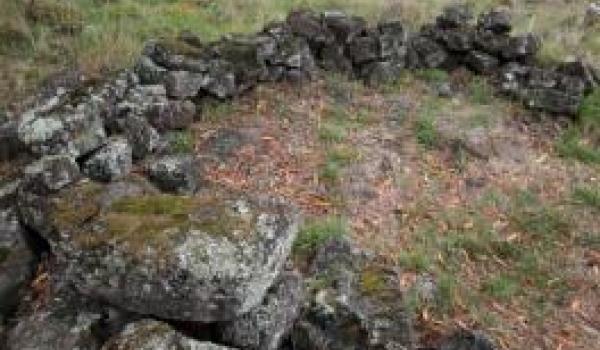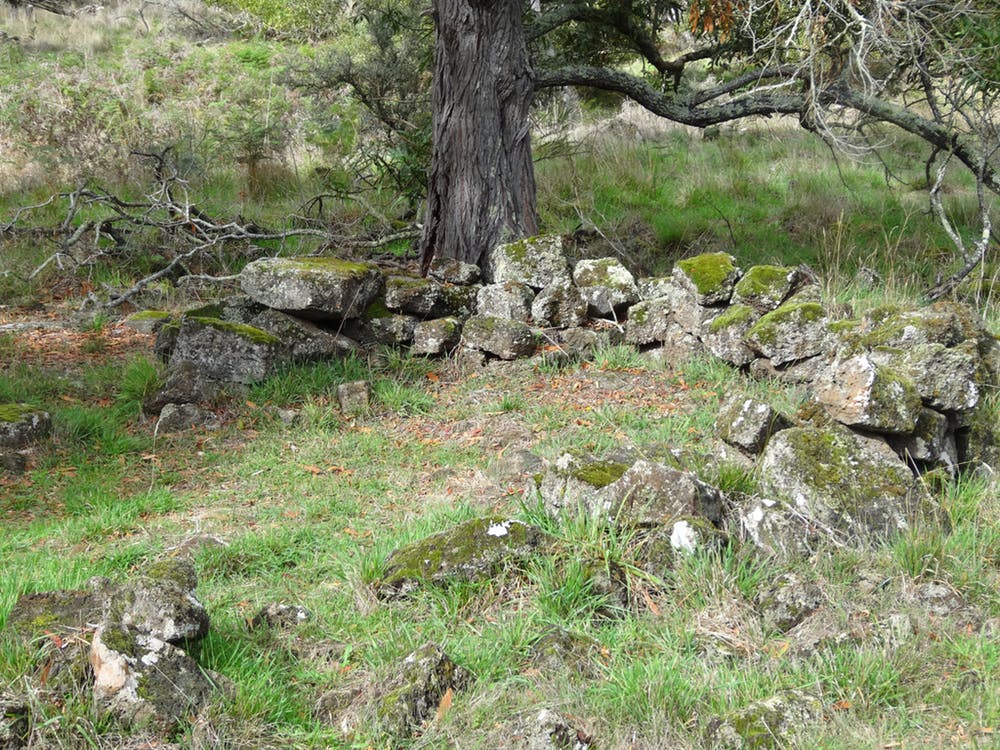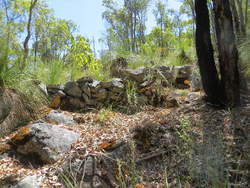'Romancing the Stones' - Mr Pascoe's Stone Village Houses
“One of the unresolved issues in all of the archaeological studies [of these stone remains] is the design and structure of roofs over these stone-walled structures…Another issue is whether some or all of the wall structures were in fact, windbreaks, not being roofed at all”. P Memmott, Gunyah, Goondie & Wurley, QUP, 2007, p205).
“The remains of a circular stone wall located on High Cliffy Island off the NW Kimberly coast, which is possibly a wind-break or may have had a spinifex or bark roof.” Mr Pascoe refers to this as a “stone house”. Copyright; WA Museum, S O’Connor. (P.Memmott, QUP)
Mr Pascoe opens his chapter in Dark Emu headed “Stone structures”, with a typically bold and unsubstantiated statement :
“Reviewing the earliest colonial reports reveals an astonishing amount of reference to stone houses and other structures. The first explorers and settlers must have seen many more houses than the ones they wrote about; but even with such reluctant witnesses, the evidence is overwhelming.” (Dark Emu, 2018 reprint, p125).
Strangely, Mr Pascoe says he has revealed an “astonishing amount of reference to stone houses”, yet he cites none of them here. He then goes on with another bout of un-Australian, self-loathing to complain about those pesky “first explorers and settlers [who] must have seen many more houses than the ones they wrote about…” Oh, those conniving early Europeans keeping secrets to thwart the research of some future intellectual!
We smelt a Bogul, so we dug a little deeper and now understand why Mr Pascoe is sparse with his citations…because most of them contradict his Aboriginal sedentary/agriculture argument!
And those “reluctant witnesses”? The only one being reluctant here is Mr Pascoe, who is reluctant to cite these witnesses, as they do not support his theory of a settled Aboriginal agricultural society living in their little stone village houses. Like most Post-modern intellectuals, Mr Pascoe would rather throw out the Evidence, than modify or ditch the Theory !
Let’s look at Peter Manifold who Mr Pascoe refers to on page 128 as an “…early colonist…who described the buildings [the stone houses of Lake Condah] in great detail”.
However, Mr Pascoe does not provide a citation of where we can see Peter Manifold’s original descriptions. So, the first book we open, R. Brough Smyth’s, “The Aborigines of Victoria”, which was compiled for the Victorian Government in 1876, has what we are looking for in Vol II on page 235 of the 1972 Edition, and we quote:
“Mr. Peter Manifold, who has resided on his estate in the district in question for more than thirty years, has kindly given me the following valuable information on the subject :— ‘The stone-circles are made by the natives, and are always found in exposed situations where timber is difficult to obtain. The natives there [Western Plains of Victoria] formed these break-winds of stones, placed on edge in a circular form, some of them very perfect, leaving the opening generally towards the east, the prevailing winds coming from the north-west and south-west.
These circles are common on the plains or eastern part of this property, where branches of trees could not be procured for giving shelter. When we first occupied this country, it was quite common for the natives to use these circles as camping-places, always having the fires in the centre. The fires were very small, as they had frequently to carry the wood long distances.
The circles are generally formed of large stones set on their edges, and bedded in the ground close together, without any other stones on the top, thus forming good protection from the wind as they lay around the fire. The stones are of the common basalt, there being no other in the district. The situation selected was generally where water was convenient, or in some favorable place for game. The circles were about the size of the ordinary mia-mys, that is from ten to twenty feet in diameter’.
I may add that the European shepherds have been in the habit of constructing rubble-walls in circles for the same purpose of protection from the winds”.
Brough Smyth also refers to a Mr Ormond describing “…rude stone-circles merely for the purpose of shelter from the keen winds…” (ibid, p 235, our emphasis).
So now we know why Mr Pascoe doesn’t seem to want to cite Peter Manifold in detail – his evidence supports the narrow view that the Aborigines only used stone to construct a basic, low wind-break in areas where timber was scarce. If timber and bark were readily available, one would presume the Aborigines would construct wind-breaks and huts in timber, rather than in stone. Hardly an endorsement that Aboriginal society lived a settled and permanent agricultural existence in stone-houses.
In another excellent report, by Sharon Lane, “Aboriginal stone structures in southwestern Victoria”, For Aboriginal Affairs Victoria, 2009, details are given of other witnesses of stone structures in colonial Victoria, namely on page 15:
Alexander Ingram/R.E. Johns – early site description, with Aboriginal informant
“Near a large waterhole in a fine permanent stream known as ‘The River’ are the remains of an old aboriginal camping-place, the name of which is Narrarrabeen, consisting of about twenty stone foundations, of horseshoe form, from 4ft to 7ft in diameter, and opening towards the east, a point from which the wind rarely blows. They are built among the loose blocks of cellular basalt, and appear to have been made by piling the stones removed to level the floor into a dry-stone wall about 1ft high on the western or windward side. On this foundation – Mr Ingram learned from Tommy White, a civilised aboriginal, who had been born at a similar camping place (called by the blacks Allumyung, about a quarter of a mile higher up the river, near the point at which it issued from beneath the basalt) – the ordinary mia mia of bark was erected. In the forest, not far distant, is another old camping ground, called Eullameet. Similar stone foundations are found among the rough basalt around Mount Eccles and Lake Gorrie (Johns quoted in Worsnap 1897: 105-106)”. (our emphasis).
The archeological conclusion of Sharon Lane’s report is that :
“Generally the stone-based huts of the Mt Eccles region have been described as low stone walls built by piling unmodified blocks of basalt on top of one another, [they] are semi-circular to U-shaped and usually 2-4m, across. The insides of the structures are relatively clear of rocks, although walls have partially collapsed (Wesson 1981: 31).” (ibid page 15).
and
“Aboriginal stone hut bases in western Victoria are found, for the most part, only on the stony rises of the region…” “The archaeological identification of the stone-based huts of the western Victorian stony rises has been a matter of some debate amongst archaeologists. Again the main difficulties that may occur in trying to accurately identify stone-based huts from the ground surface are (a)confusion with non-Aboriginal structures : There are a relatively large number of non-Aboriginal structures built from basalt blocks on the stony rises, particularly in the Lake Condah area”….and…. “there do exist a small number of European site types which could be confused with Aboriginal structures”.; and (b) confusion with natural features which might result in the creation of small [natural] circular arrangements of stone on the stony rises.” (ibid page 22).
Remains of a rock-wall bird hide in the Northern Territory. Possibly easily confused with one of Mr Pascoe’s “stone-houses”. (Photograph by R Reser ANU, from P. Memmott, Gunyah, Goondie & Wurley, QUP 2007).
The archaeologist, Dr Annie Clarke in her paper “Romancing the Stones”(1) challenges interpretations such as Mr Pascoe’s that the stone–wall ruins are Aboriginal stone-houses, but instead are most are likely just low-foundation walls to support timber domed structures, wind-breaks or day-time hunting blinds. She found that the stone circles occurred mostly in stony country where timber could not easily be dug into the soil. The ‘walls’ also usually consisted of only one or two stone courses, 0.50 to 0.75m high and were more in keeping with foundations for hut-bases rather than walls for stone houses.
So it looks again as if Mr Pascoe is using “rubber-band analysis” to stretch the evidence to fit his Post-modern theory.
But let the reader judge from the photographs below, from around Australia, of stone structures, which Mr Pascoe suggests we refer to as “stone houses”.
(1) : The Cultural Construction of an Archaeological Landscape in the Western District of Victoria, in Archaeology in Oceania, vol 29, pp 1-15).
And we will let Dr Josephine Flood, “a prominent archaeologist, recipient of the Centenary Medal and former director of the Aboriginal Heritage section of the Australian Heritage Commission”, have the last word :
“The inhabitants of this fertile region [Lake Condah], later known as Australia Felix, were more sedentary than most other hunter-gatherers, but still moved camp several times each year. In March to April, several hundred people assembled to exploit eels and each family built itself a temporary hut. Such hut-groups were not permanent and to describe them as some have done as “villages of stone houses” is a slight exaggeration. The term ‘village’ implies permanent residents living in a cluster of permanent homes in the country. Nowhere in Aboriginal Australia did this happen; even in the richest environments people moved camp several times a year as local food supplies were exhausted. Even eel fishermen moved every month or so….The main reason for such frequent moves were to obtain varied, fresh food and avoid the rubbish [and sewage] that built up and the insect pests that were attracted when they camped in one place for too long” - Dr Josephine Flood, The Original Australians, Allen&Unwin, 2019, p239-240.








